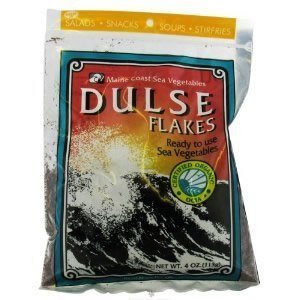Dulse
- Posted on October 9, 2012
- in Nutrition, What The @#$! Is That?
- by Natalie
You know when you’re in the ocean and you get that paranoid creepy feeling that something is going to swim up and bite ya under that murky water? Then suddenly you feel a slimy tentacle rubbing against your legs and you frantically swim away to save yourself from the horrors that live beneath? No? Just me? Well don’t worry, it’s just some Dulse!
So what the @#$! is it? Dulse is a seaweed!
Dulse is a fantastic source for calcium, zinc, manganese, potassium, iron, and magnesium. Zinc helps people with hormonal imbalances. It is also high in iodine which helps those suffering from hypothyroidism. Take these excerpts from seaveg.com:
Iodine: ‘Dr. Ryan Drum, noted herbalist and sea vegetable gatherer, states in Therapeutic Use of Seaweeds (Proceedings of the 2001 Pacific Northwest Herbal Symposium) “Seaweeds, eaten regularly, are the best natural food sources of biomolecular dietary iodine… no land plants are reliable sources of dietary iodine.” For comparison, you would have to eat about 40 lb. of fresh vegetables and/or fruits to get as much iodine as you would from 1 gram of our whole leaf kelp.’
Wowwy! That’s a lot o’ iodine.
B Vitamins: ‘A serving of Dulse (about 7g, 1/3 cup) provides about 10% RDA Vit B-2 (Riboflavin) and about 42% RDA Vit B-6.’
Protein: ‘The red sea vegetables, Dulse and Laver, are higher than the browns, Kelp and Alaria. The amino acid composition of these sea veggie proteins is generally well balanced and contains all or most of the essential amino acids (the ones your body can’t produce by itself). Thus the sea veggies provide higher quality protein than certain grains and beans that are lacking one or two essential amino acids, although the sea vegetables provide less quantity per serving. (Example: A serving of Dulse would yield about 1 1/2 g of high quality protein).’
Fiber: ‘Our four sea vegetables — Dulse, Kelp, Alaria, Laver — tested about 30% total fiber, about one half of which is soluble fiber and one half insoluble. For comparison, Dulse has about 33% total fiber, as much as oat bran. Of course, because you usually eat a larger serving size of oat bran than of sea vegetables, you’ll get more fiber per serving from the oat bran. But every time you eat sea vegetables, you’re getting high quality and very special fiber.’
Check out this chart to see how jam packed with nutrion Dulse is. This chart is for a serving of 4.9g or 1 tablespoon:
| Energy | 13 kcal |
| Protein | 1 g |
| Total lipid (fat) | ~ g |
| Carbohydrate, by difference | 2 g |
| Fiber, total dietary | 2 g |
| Sugars, total | ~ g |
| Calcium, Ca | 10 mg |
| Iron, Fe | 2.52 mg |
| Magnesium, Mg | 20 mg |
| Potassium, K | 391 mg |
| Sodium, Na | 87 mg |
| Vitamin C, total ascorbic acid | ~ mg |
| Riboflavin | 0.142 mg |
| Niacin | 0.201 mg |
| Vitamin B-6 | 0.598 mg |
| Vitamin B-12 | 1.02 mcg |
| Vitamin A, IU | 50 IU |
| Fatty acids, total saturated | ~ g |
| Fatty acids, total trans | ~ g |
| Cholesterol | ~ mg |
http://caloriecount.about.com/calories-maine-coast-dulse-flakes-i211095
Naturalie’s note: As it is a seaweed, Dulse is very high in sodium so it has a salty, fishy taste. But in general, Dulse is so high in vitamins and good stuff that you only need a little to get the nutritional benefits and some added flavor.
Tags: dulse, fiber, iodine, iron, magnesium, manganese, potassium, protein, sea veg, sea vegetable, sea weed, seaweed, vegetable, vitamin b, zinc

